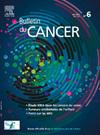Thérapies ciblées en situation néoadjuvante dans le cancer du sein : place des iCDK4/6 et des iPARP
IF 0.8
4区 医学
Q4 ONCOLOGY
引用次数: 0
Abstract
Au cours des dix dernières années, les thérapies ciblées ont profondément modifié le pronostic des cancers du sein au stade métastatique. Les inhibiteurs de CDK4/6 et de PARP prennent désormais une place croissante en situation adjuvante, et leur utilisation est également explorée en contexte néoadjuvant. Cette revue propose une analyse des données scientifiques disponibles et des perspectives cliniques associées. Les inhibiteurs de CDK4/6 ciblent les altérations du cycle cellulaire fréquemment observées dans les cancers du sein hormonodépendants. En situation adjuvante, l’abémaciclib et le ribociclib ont démontré un bénéfice en survie sans progression dans les essais monarchE et NATALEE, respectivement, ce qui a conduit à leur autorisation de mise sur le marché (AMM) en Europe. En contexte néoadjuvant, bien que ces molécules aient montré une réduction des marqueurs de prolifération tels que le Ki67, leur impact clinique reste à ce jour limité. Les inhibiteurs de PARP reposent sur le principe de létalité synthétique, ciblant en particulier les cancers associés à des mutations germinales de BRCA1 ou BRCA2. En adjuvant, l’étude OlympiA a mis en évidence une amélioration significative de la survie sans progression ainsi que de la survie globale. En situation néoadjuvante, ces agents ont également démontré un effet sur certains marqueurs pathologiques, bien que la traduction clinique de ces résultats reste à clarifier. Ces données confirment le rôle croissant de ces thérapies ciblées en adjuvant dans la pratique actuelle. L’identification et la validation de biomarqueurs prédictifs apparaissent essentielles pour optimiser leur utilisation, tant en situation adjuvante que néoadjuvante.
Over the past decade, targeted therapies have significantly improved the prognosis of metastatic breast cancer. CDK4/6 and PARP inhibitors are now gaining traction in the adjuvant setting, and their potential use in the neoadjuvant context is also being explored. This review presents an analysis of the current scientific evidence and associated clinical perspectives. CDK4/6 inhibitors act on cell cycle dysregulation, commonly observed in hormone receptor-positive breast cancers. In the adjuvant setting, abemaciclib and ribociclib have shown improvements in progression-free survival (PFS) in the monarchE and NATALEE trials, respectively, leading to their approval by the European Medicines Agency. In the neoadjuvant context, although these agents have demonstrated a reduction in proliferation markers such as Ki67, their impact on clinical practice remains limited to date. PARP inhibitors are based on the concept of synthetic lethality, specifically targeting cancers with germline BRCA1 or BRCA2 mutations. In the adjuvant setting, the OlympiA trial demonstrated a significant improvement in both PFS and overall survival (OS). In the neoadjuvant setting, these agents have also shown effects on pathological markers, though the clinical relevance of these findings has yet to be clearly established. Overall, these results underscore the growing role of targeted therapies in the adjuvant management of breast cancer. The identification and validation of predictive biomarkers will be crucial in optimizing their use, both in adjuvant and neoadjuvant settings.
靶向治疗新辅助乳腺癌:CDK4/6和PARP抑制剂的作用。
在过去的十年中,靶向治疗显著改善了转移性乳腺癌的预后。CDK4/6和PARP抑制剂目前在辅助治疗中越来越受关注,它们在新辅助治疗中的潜在应用也在探索中。这篇综述分析了目前的科学证据和相关的临床观点。CDK4/6抑制剂作用于细胞周期失调,常见于激素受体阳性乳腺癌。在辅助治疗方面,abemaciclib和ribociclib分别在monarchE和NATALEE试验中显示出无进展生存期(PFS)的改善,从而获得了欧洲药品管理局(European Medicines Agency)的批准。在新辅助治疗的背景下,尽管这些药物已经证明了Ki67等增殖标志物的减少,但迄今为止,它们对临床实践的影响仍然有限。PARP抑制剂基于合成致死性的概念,专门针对生殖系BRCA1或BRCA2突变的癌症。在辅助治疗中,OlympiA试验显示PFS和总生存期(OS)均有显著改善。在新辅助治疗中,这些药物也显示出对病理标志物的影响,尽管这些发现的临床相关性尚未明确确立。总的来说,这些结果强调了靶向治疗在乳腺癌辅助治疗中的作用越来越大。无论是在辅助治疗还是新辅助治疗中,预测性生物标志物的鉴定和验证对于优化其使用至关重要。
本文章由计算机程序翻译,如有差异,请以英文原文为准。
求助全文
约1分钟内获得全文
求助全文
来源期刊

Bulletin Du Cancer
医学-肿瘤学
CiteScore
1.90
自引率
16.70%
发文量
224
审稿时长
37 days
期刊介绍:
Without doubt, the ''Bulletin du Cancer'' is the French language publication of reference in the field of cancerology. Official organ of the French Society of Cancer, this journal covers all the information available, whether in the form of original articles or review articles, but also clinical cases and letters to the editor, including various disciplines as onco-hematology, solids tumors, medical oncology, pharmacology, epidemiology, biology as well as fundamental research in cancerology. The journal proposes a clinical and therapeutic approach of high scientific standard and regular updates in knowledge are thus made possible. Articles can be submitted in French or English.
 求助内容:
求助内容: 应助结果提醒方式:
应助结果提醒方式:


